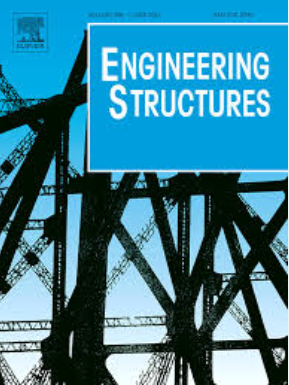一种新的混凝土梁接触爆炸局部破坏的水弹塑性损伤本构模型
IF 6.4
1区 工程技术
Q1 ENGINEERING, CIVIL
引用次数: 0
摘要
当建筑物受到爆炸或弹道冲击等极端动荷载作用时,确定钢筋混凝土构件的局部损伤和整体动力响应对于评估结构的损伤和整体稳定性至关重要。数值模拟作为预测钢筋混凝土构件局部损伤的重要方法,依赖于材料模型的准确性。混凝土是一种典型的应变软化材料,在有限元非线性分析过程中变形的局部化可能导致非物理网格尺寸依赖,如KCC, HJC, RHT, CSC和Kong-Fang等混凝土动态模型中所见。此外,这些模型不能考虑材料刚度的退化,即不能准确预测材料波阻抗的变化,从而不能描述应力波在构件内的传播。虽然先前提出的Yan-Chen2.0模型(Int J Impact Eng, 198(2025):105226)已经解决了这些问题,并提供了详细的建模过程,但它没有进行刚度退化和网格尺寸独立性的定量验证。此外,该方法在预测钢筋混凝土梁接触爆炸局部损伤程度方面缺乏适用性评价。基于Yan-Chen2.0模型,本文首先回顾了建模策略。然后,采用不同网格尺寸的单轴压缩(UUC)和单轴拉伸(UUT)数值试验,以及循环静水压缩、循环单轴拉压和拉压循环三种加载方案下的单单元数值试验。这些测试与上述五个具体模型相结合,定量分析Yan-Chen2.0模型的适用性。最后,通过对钢筋混凝土梁的接触爆炸试验,分析比较了6种模型预测的局部破坏模式与网格尺寸的相关性。结果表明,Yan-Chen2.0模型可以有效降低UUC和UUT的网格尺寸依赖性;可以捕捉到循环加载下卸载过程中的刚度退化,应变软化段与试验结果基本吻合。在钢筋混凝土梁接触爆炸作用下,网格尺寸对预测钢筋混凝土梁局部破坏模式和动力响应的依赖性最低,能够揭示钢筋混凝土梁在应力波作用下的破坏机理。该研究为钢筋混凝土构件局部破坏数值预测中材料模型的选择提供了参考。本文章由计算机程序翻译,如有差异,请以英文原文为准。
A novel hydro-elastoplastic damage constitutive model for local failure prediction of RC beams under contact explosion
When buildings are subjected to extreme dynamic loads such as explosions or ballistic impacts, determining the local damage and overall dynamic response of reinforced concrete (RC) components is crucial for assessing the damage and overall stability of the structure. Numerical simulation, as an important method for predicting the local damage of RC components, relies on the accuracy of the material models. For concrete, a typical strain-softening material, the localization of deformation during finite element nonlinear analysis can lead to non-physical mesh size dependency, as seen in concrete dynamic models such as KCC, HJC, RHT, CSC, and Kong-Fang. Moreover, these models fail to account for the degradation of material stiffness, that is, cannot accurately predict changes in material wave impedance, and thus cannot describe the propagation of stress waves within the components. Although the previously proposed Yan-Chen2.0 model (Int J Impact Eng, 198(2025):105226) has addressed these issues and provided a detailed modeling process, it has not conducted quantitative verification of stiffness degradation and mesh size independence. Moreover, it lacks an evaluation of its applicability in predicting the local damage degree of RC beams under contact explosion. Based on the Yan-Chen2.0 model, this paper first reviews the modeling strategy. Then, it uses uniaxial compression (UUC) and uniaxial tension (UUT) numerical tests with different mesh sizes, as well as single-element numerical tests under three loading schemes: cyclic hydrostatic compression, cyclic uniaxial tension and compression, and tension-compression cycling. These tests are combined with the five aforementioned concrete models to quantitatively analyze the applicability of the Yan-Chen2.0 model. Finally, using the contact explosion tests on RC beams, the mesh size dependency of the predicted local failure modes by the six models was analyzed and compared. The results show that the Yan-Chen2.0 model can effectively reduce mesh size dependency in UUC and UUT; it can capture stiffness degradation during unloading under cyclic loading, with the strain-softening segment basically matching the experimental results. Under RC beam contact explosion, it has the lowest mesh size dependency in predicting local failure modes and dynamic responses, and can reveal the failure mechanism of RC beams under stress wave action. This study provides a reference for the selection of material models in numerically predicting local failure of RC components.
求助全文
通过发布文献求助,成功后即可免费获取论文全文。
去求助
来源期刊

Engineering Structures
工程技术-工程:土木
CiteScore
10.20
自引率
14.50%
发文量
1385
审稿时长
67 days
期刊介绍:
Engineering Structures provides a forum for a broad blend of scientific and technical papers to reflect the evolving needs of the structural engineering and structural mechanics communities. Particularly welcome are contributions dealing with applications of structural engineering and mechanics principles in all areas of technology. The journal aspires to a broad and integrated coverage of the effects of dynamic loadings and of the modelling techniques whereby the structural response to these loadings may be computed.
The scope of Engineering Structures encompasses, but is not restricted to, the following areas: infrastructure engineering; earthquake engineering; structure-fluid-soil interaction; wind engineering; fire engineering; blast engineering; structural reliability/stability; life assessment/integrity; structural health monitoring; multi-hazard engineering; structural dynamics; optimization; expert systems; experimental modelling; performance-based design; multiscale analysis; value engineering.
Topics of interest include: tall buildings; innovative structures; environmentally responsive structures; bridges; stadiums; commercial and public buildings; transmission towers; television and telecommunication masts; foldable structures; cooling towers; plates and shells; suspension structures; protective structures; smart structures; nuclear reactors; dams; pressure vessels; pipelines; tunnels.
Engineering Structures also publishes review articles, short communications and discussions, book reviews, and a diary on international events related to any aspect of structural engineering.
 求助内容:
求助内容: 应助结果提醒方式:
应助结果提醒方式:


